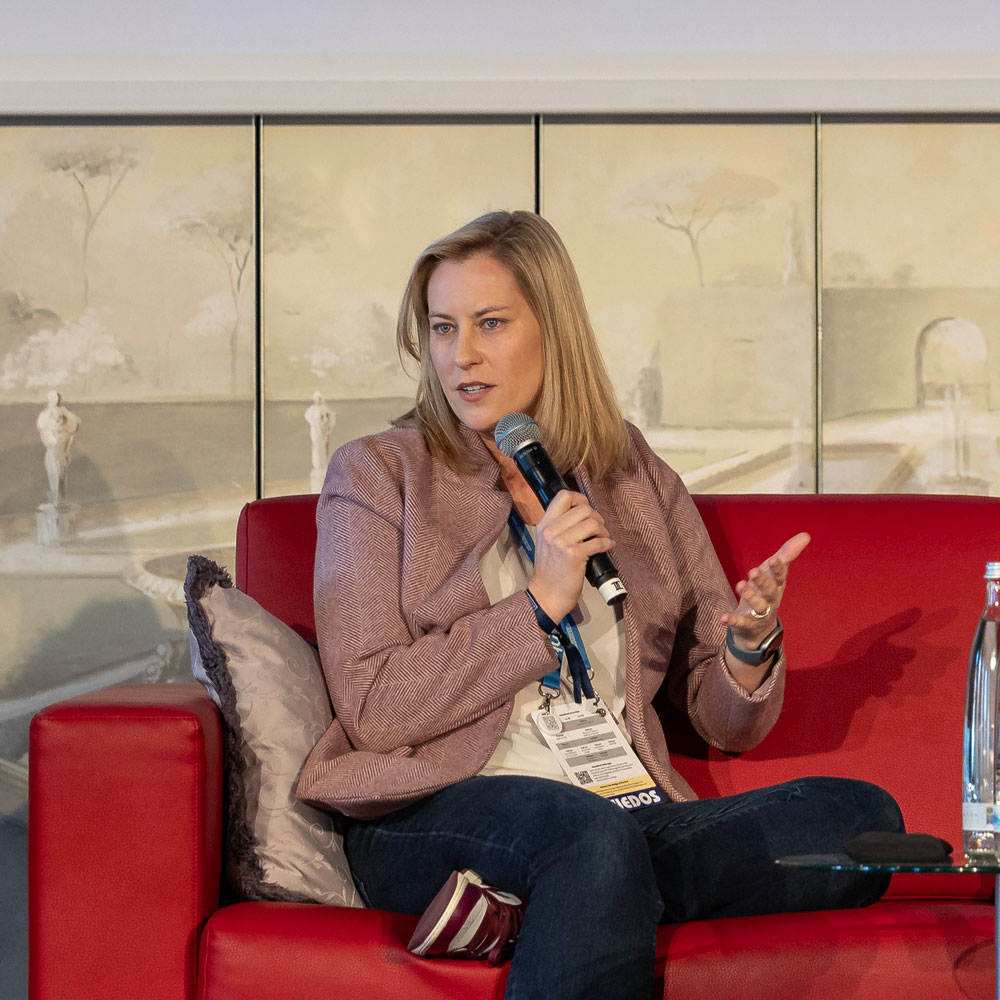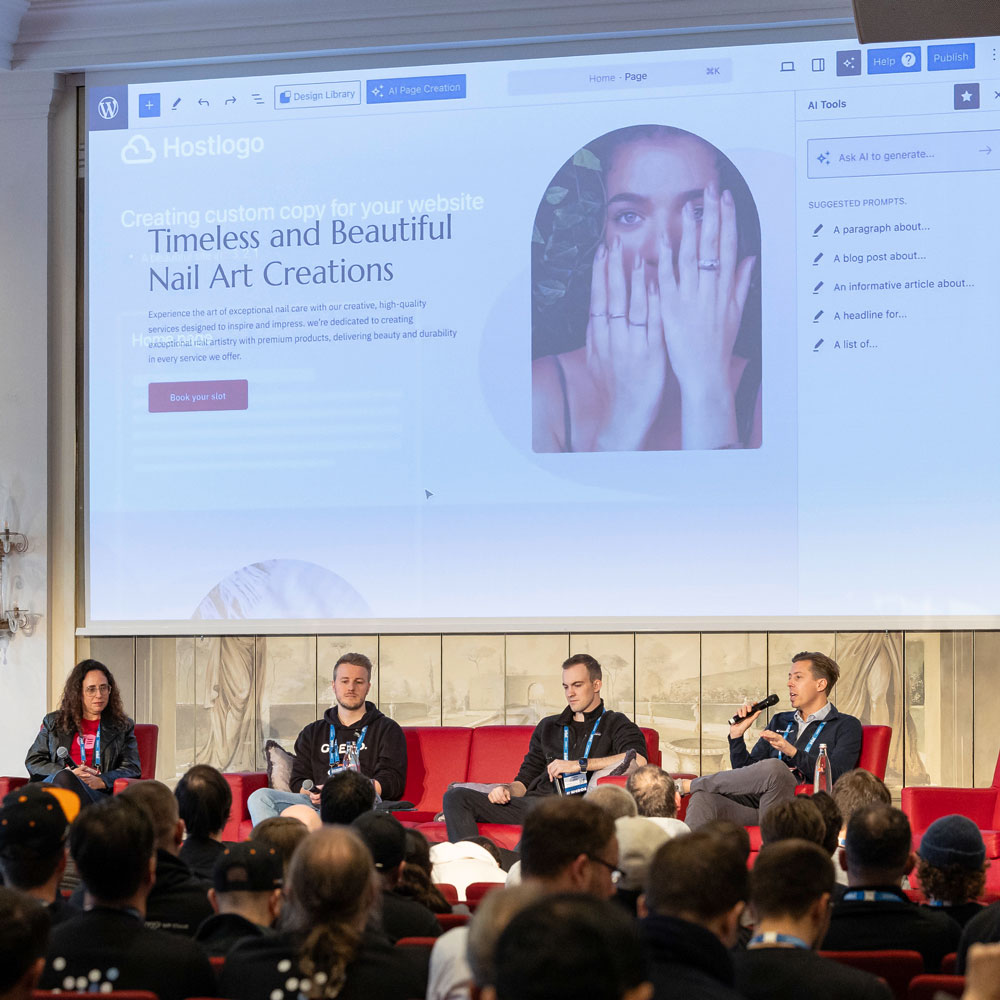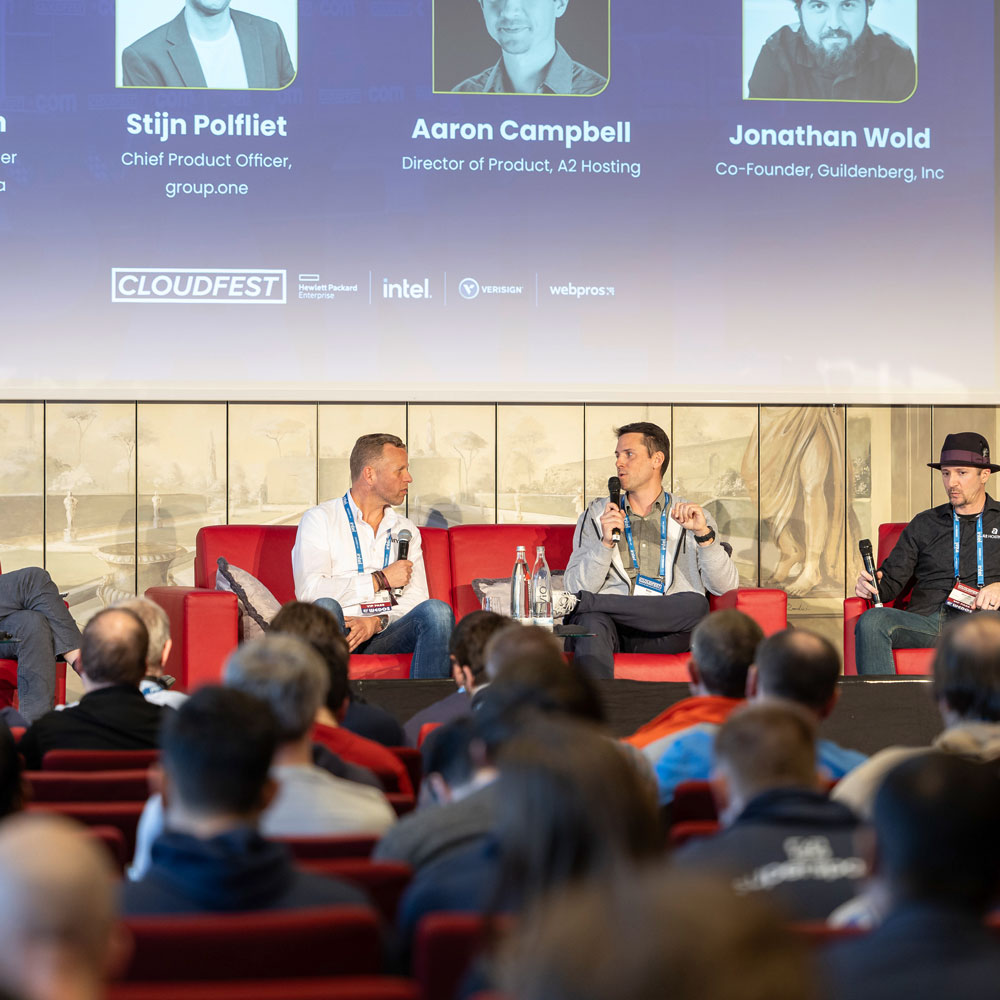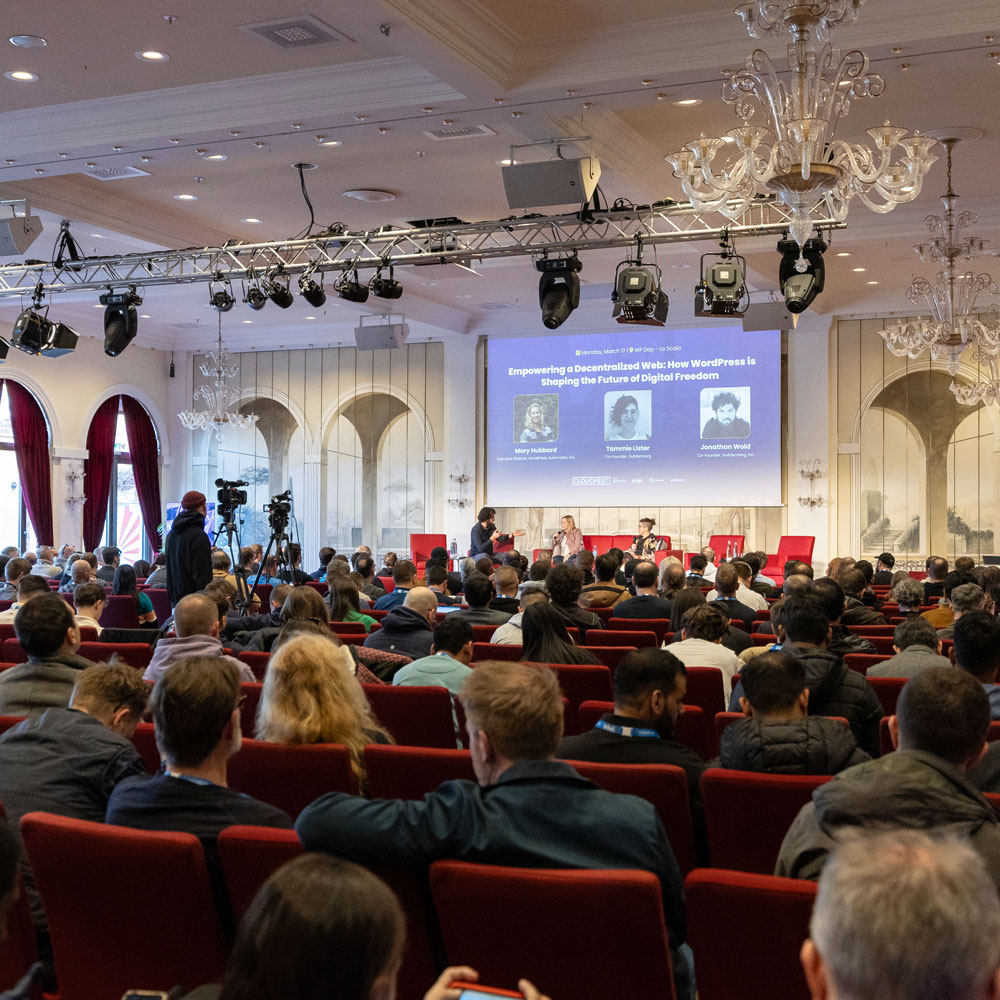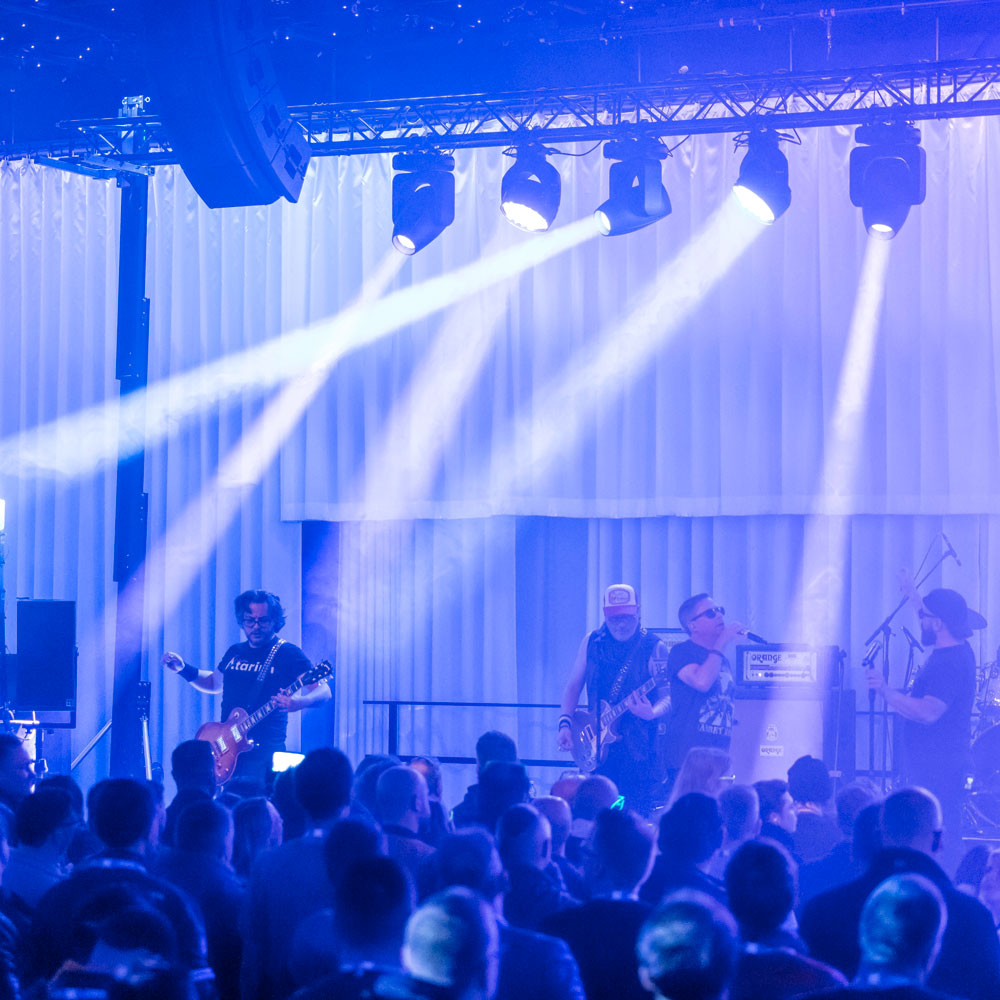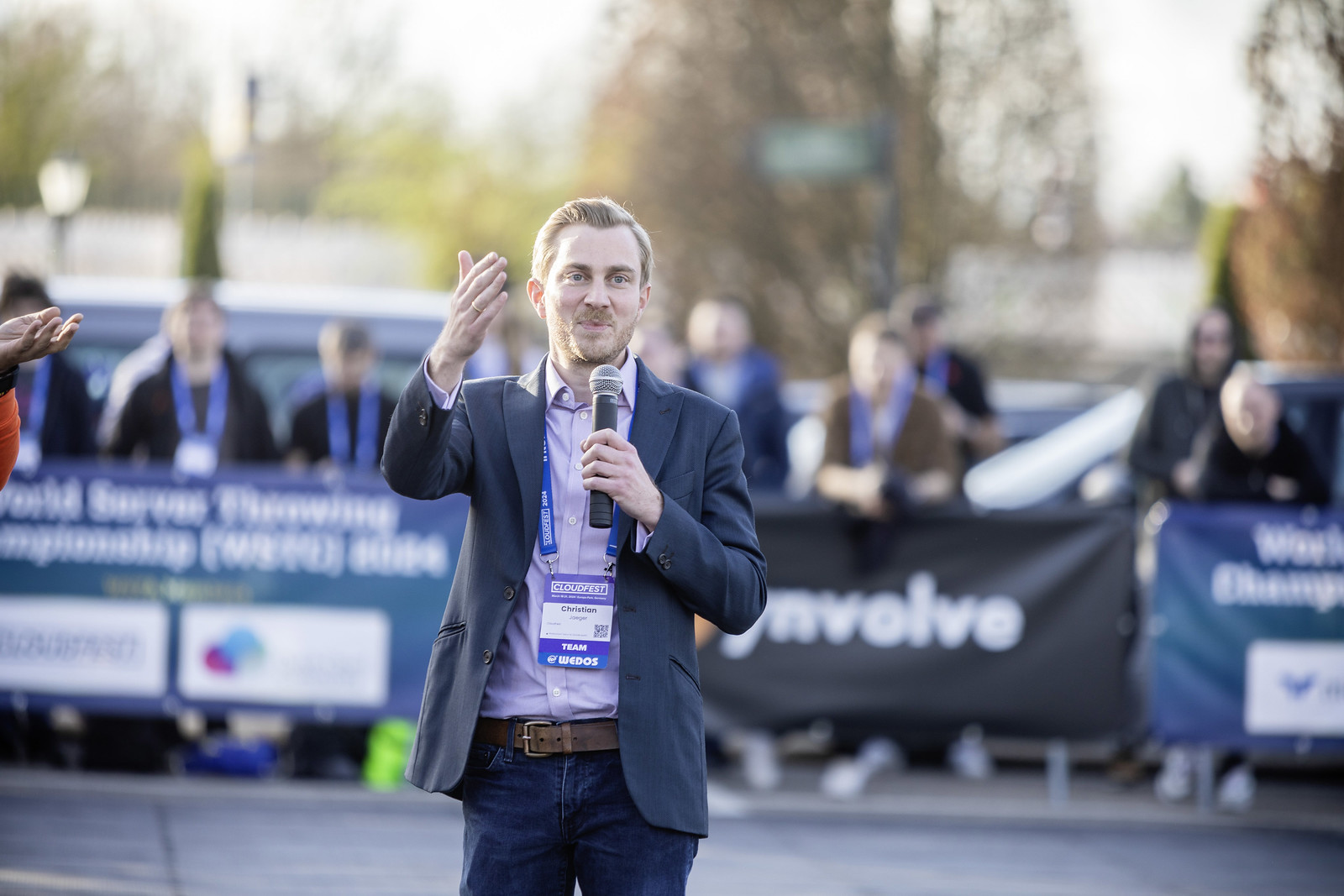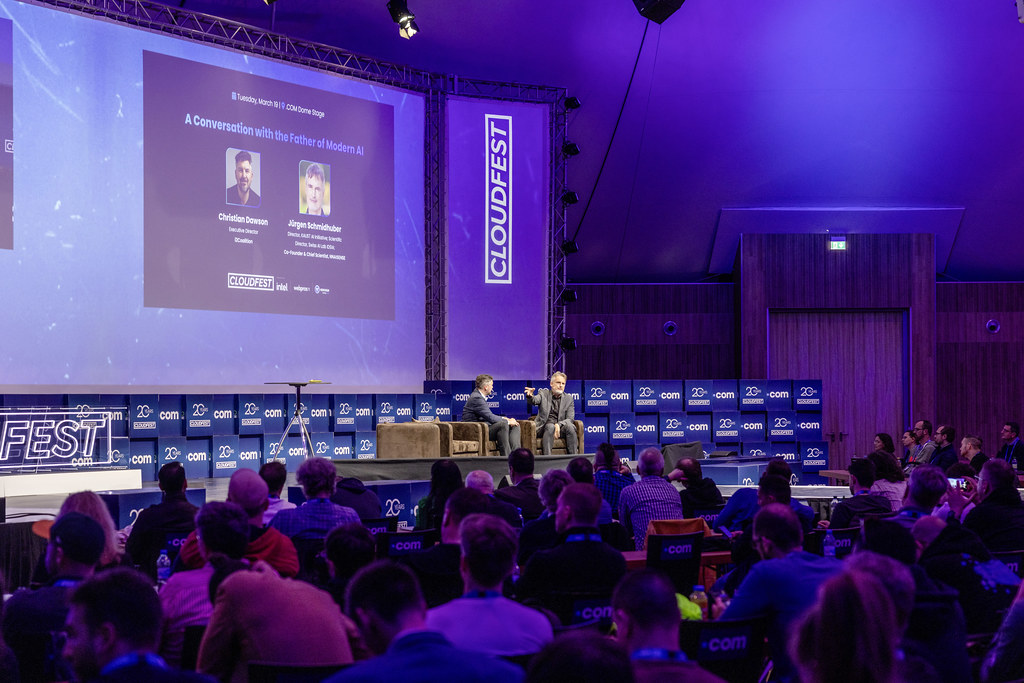Cloudfest 2025 took over Europa-Park for a vibrant festival of technology and innovation, exploring and celebrating the most important thing in the age of AI: humanity.
Where else could you listen to a talk by Tor creator Roger Dingledine and then immediately accelerate to 100 km/h on a speeding rollercoaster?
Alongside insightful discussions around the future of the Cloud and the internet itself, attendees chilled at after-parties stretching deep into the night and watched startups battle it out (with words) in a boxing ring.
Day 0: All About WordPress and Web Agencies
The first day of CloudFest 2025 kicked off with a focus on WordPress and web agencies, even as the open-source Hackathon wrapped up. (The 2025 CloudFest Hackathon gets its own recap!)
The sessions ranged from cybersecurity to domain name infrastructure, providing Cloud professionals with insights on improving both the security and scalability of WordPress websites, two key aspects of managing digital environments.
WordPress Security: A Continuous Process
Oliver Sild, a cybersecurity expert, took the stage to shed some light on the complexities of WordPress security. Sild, drawing on years of research and data, emphasized that security is not a one-time solution but an ongoing process.
He broke down website security into four essential layers:
- Physical Layer: Centered on human behavior and decision-making
- Network Layer: Featuring tools like CDNs and network firewalls
- Server Level: Ensuring the infrastructure and hosting are consistently secure
- Application Layer: Focusing specifically on WordPress vulnerabilities
“Security is not something you just get,” Sild warned. “It’s not a single button you install. Security is a process that takes time and care, and something you continuously improve.” This message was especially relevant to CSPs, who must understand the nuances of security beyond just configuring firewalls or installing plugins. As Sild pointed out, each layer of security must be actively maintained.
A Shift Toward Domain Names: Insights from Andy Simpson
While Sild’s session focused on securing WordPress sites, Andy Simpson, Vice President of Business Intelligence and Data Analytics at Verisign, addressed a different but equally important facet of managing online identities: domain names.
The demand for domain registrations has surged, especially since the pandemic, as businesses continue to transition to the digital space. “The demand for new registrants is continuing to climb,” Simpson noted, emphasizing the critical role domains play in helping businesses establish their identities online.
Simpson also touched on the broader domain lifecycle, emphasizing that service providers need to focus on the first year of domain registration, as it’s the most critical time for retention. “If your customers are using their domains for more than just registration—whether it’s for email or a live website—they’re much more likely to renew,” Simpson explained.
Day 1: Cory Doctorow and Albert Einstein
Doctorow: How Big Tech Broke the Internet and What We Can Do About It
On Tuesday, acclaimed journalist, activist, and author Cory Doctorow delivered a compelling talk on the “enshittification” of the internet, arguing against letting big companies dictate all the rules at the user’s—and internet’s—expense.
Doctorow advocated for fairer laws to boost competition, lower prices, and empower people to repair and customize their own products.
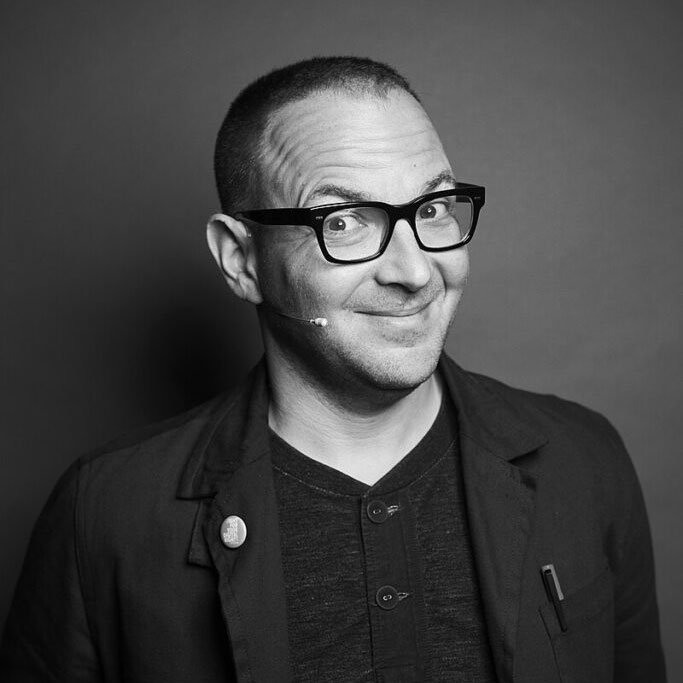
He specifically targeted major corporations whose practices impact our daily lives. For example, the use of digital locks on printers, forcing customers to purchase overpriced ink cartridges. Facebook initially attracted users, then flooded their feeds with ads and harvested personal data for profit. Similarly, Apple locks users into its App Store, charging developers steep fees of up to 30%.
These restrictive practices, Doctorow explained, raise costs, limit consumer choice, prevent product customization and repairs, compromise privacy, and lock users into inferior services.
Doctorow’s argument was underscored dramatically just days before the event, when four Tesla cars were set on fire in Berlin, highlighting consumer frustration with corporate control and restrictive technology practices.
Make sure you read Doctorow’s interview with our Senior Copywriter and Content Lead Jordan Yerman to get more from this gentleman’s singular brain.
Einstein (Sort Of) Takes the Stage at CloudFest
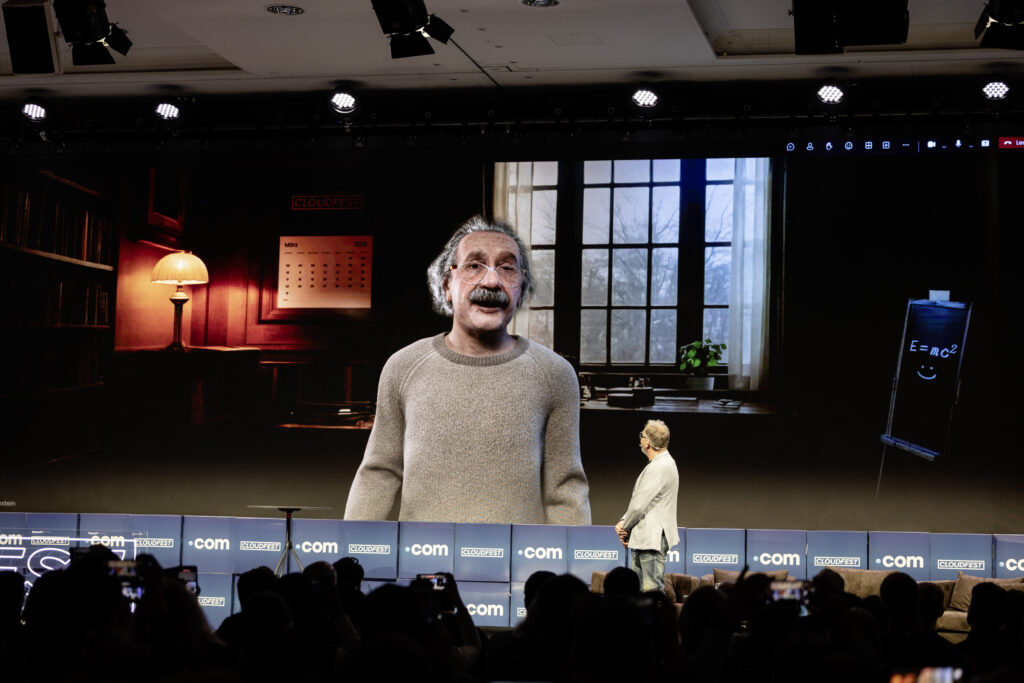
CloudFest is all about delivering the unexpected, and this one truly bent time and reality. On the main stage, CloudFest Chief Evangelist Soeren von Varchmin introduced our most surprising guest yet: a digital recreation of Albert Einstein.
Designed by 1SP Agency, this AI-powered session was part fireside chat and part thought experiment. “I’ve been trying to get him here for two decades,” Soeren joked, before Einstein appeared onscreen—calm, clever, and with a ring light on.
Einstein opened by describing his work as “a dance between imagination and rigorous mathematics” before diving into today’s biggest tech dilemmas. He praised the speed of progress but urged caution, warning, “We must not let the pursuit of progress overshadow the preservation of humanity’s well-being.”
On AI, Einstein drew parallels with the moral questions raised by nuclear science in his lifetime. Innovation, he said, must be matched by ethics, governance, and global cooperation. The avatar also weighed in on quantum computing, calling it promising but still far from scalable due to major technical challenges.
The physicist was insightful, if occasionally glitchy (understandable, perhaps, for someone who would be 146 years old). Still, even with the odd pause, his message was clear: progress without purpose is just noise.
Day 2: Surfing Freely and CoPilot Oversharing Your Data
Roger Dingledine: Rethinking Power, Privacy, and the Future of the Internet
On Wednesday, Tor Project Co-founder Roger Dingledine, who offered us a fascinating interview to preview his appearance at CloudFest 2025, laid out a decades-long fight for internet privacy, anonymity, and decentralization.
The session opened with a quick nod to Tor’s origins: a research collaboration with the U.S. Naval Research Lab and a bold experiment in onion routing. But what started as an academic project quickly grew into one of the most important tools for digital anonymity and civil liberties.
Dingledine recounted how his early vision was shaped by a desire to resist surveillance from corporations like Google: “I wanted to be able to do a search without ending up in their datasets,” he said, but soon realized Tor had far broader implications.
But the conversation didn’t shy away from controversy. Moderator Christian Dawson, Executive Director of the Internet Infrastructure Coalition, raised the recurring criticism about Tor’s funding from entities like the U.S. State Department and DARPA: doesn’t that compromise the project’s independence?
Dingledine responded plainly: “Yes, there’s tension. But we choose what we work on. We write the proposals. We pitch the priorities. And many people inside these institutions are real supporters of internet freedom.”
The heart of the conversation, though, was a critique of centralization. “So many tech business models push all the power to the middle,” Dingledine said. “Tor flips that. It empowers the individual.” He warned that cloud infrastructure, if left unchecked, risks replicating the same surveillance logic it once promised to disrupt.
To the cloud service providers and developers in the audience, Dingledine offered both praise and a challenge. “You can help,” he said. “Host Tor relays. Stop blocking Tor users. Design systems that don’t require trust in a central actor.”
When asked about the common perception that Tor is vulnerable to being compromised by state actors, Dingledine pushed back. “Yes, surveillance is powerful. But anonymity is about blending in. That’s why diversity and scale matter. And Tor’s strength comes from its users—millions of them—not from hiding behind one magic trick.”
He closed with a story from Iran. An activist training locals on internet safety realized, too late, that everyone he’d taught to use tools other than Tor had been jailed or killed. “Sometimes,” Dingledine said, “you don’t realize how much privacy you need until it’s already too late.”
Microsoft Copilot’s Data Dilemma: Experts Warn of Organizational Risks
Microsoft 365 experts Christine Eckle and Dominik Graef delivered a stark warning about the potential pitfalls of AI integration in enterprise environments, highlighting the critical importance of data governance.
The Core Message: Garbage In, Garbage Out
“Copilot won’t save you from bad data,” Eckle emphasized during the presentation. “In fact, it will amplify your existing data management problems.”
The experts painted a troubling picture of typical organizational data environments:
- Abandoned Teams channels
- Orphaned OneDrive accounts
- Long-expired guest user permissions
- Widely shared files with unrestricted access
Real-World Consequences
Graef shared a particularly alarming statistic: “We’ve seen customers turn Copilot off within two weeks of implementation.” The primary reason? Sensitive information being inadvertently surfaced by the AI tool.
The Storage and Compliance Challenge
The presentation highlighted an often-overlooked issue of AI-generated content. “Copilot-generated decks average around 50MB,” Eckle noted. “This isn’t just an insight generation problem—it’s becoming a significant storage management challenge.”
Key Recommendations
The experts outlined a clear strategy for responsible AI integration:
- Archive outdated materials
- Implement rigorous data tagging
- Secure sensitive information
- Automate permission management
“People don’t overshare maliciously,” Eckle explained. “They simply don’t understand the risk landscape.”
The Bottom Line
Graef summed up the presentation’s core message: “Copilot is powerful, but it can’t distinguish between valuable information and digital clutter. If your tenant is a mess, Copilot will serve that mess back to you, just in a more polished format.”
The presentation served as a critical wake-up call for organizations rushing to implement AI tools without first addressing fundamental data governance challenges.
One Mic, One Ride, 30 Seconds: Founders Pitch Their Ideas on a Rollercoaster

Founders had just 30 seconds to pitch their ideas while strapped into a moving rollercoaster, delivering their vision before the big drop. But the ride didn’t stop there: after surviving the thrill, they stepped into a boxing ring to defend and expand on their ideas in front of a jury of investors and entrepreneurs.
One of those bold founders was Julia A. Carpenter from Apheros, who pitched a material science breakthrough that could change the future of liquid cooling.
Off the tracks and back on solid ground at CloudFest, Carpenter shared with us how Apheros is using advanced metal foams to revolutionize liquid cooling and boost energy efficiency from the chip up.

A few words: what is Apheros all about?

We’re a materials manufacturing company, which differs from what you typically see at CloudFest. Our focus is on metal foams for liquid cooling applications. We enhance the performance of cold plates, boiler plates, and other technical components that go into advanced cooling systems.

Liquid cooling has been around a while. What makes what you’re doing new or different?

That’s true—liquid cooling isn’t new. What’s new is how we’re improving its performance through our materials. Think of this as moving from the old way of cooling to a more efficient, advanced approach.

So is the goal primarily energy savings?

Exactly. Efficiency on-chip translates directly to major energy savings across the facility. A more efficient chip-level cooling system can lead to a 4x improvement in overall facility energy use. That’s why the work we do at the materials level is so impactful.

What brought you to CloudFest?

Honestly? Part of the reason was Europa Park. We couldn’t pass up the chance to check out the rides! But really, we’re here to connect with local people and partners in Europe. We’ve done a few fairs in the U.S. and internationally, but we wanted to understand what’s happening here and build relationships with those close to our base in Zurich.
Improv Comedy at an Internet Infrastructure Festival?!
Professional actors Julie Nolke and Gina Louise Philips wowed the packed .COM Ballroom with their fast-paced, insightful, and hilarious improv comedy demonstration. While it seems very strange to include in a Cloud event agenda, no exploration of The Human Edge is complete without a deep dive into active listening, empathy, and thinking on your feet.
Nolke and Philips followed up with two hands-on improv masterclasses, each of which was packed. What happened in those sessions, stays in those sessions!
Day 3: Pioneering the Internet and Rethinking Storage
George Sadowsky – fight against “information poverty”
In an age where information flows freely and globally, it’s easy to forget that access to knowledge has not always been a given. For George Sadowsky—computer scientist, UN advisor, and one of the early champions of internet accessibility in developing countries—the fight against “information poverty” has defined his career.
The Birth of a Concept
The idea of “information poverty” took shape in the 1970s while Sadowsky was working with the United Nations. After a stint in applied mathematics and computer center management, he joined the UN with the goal of supporting newly independent nations as they built their administrative and technological infrastructure. He describes the job as a kind of diplomatic troubleshooting role: “If there was a problem in a country, they sent in one UN specialist—and he solved the problem.”
In one such instance, Sadowsky found himself in Kigali, Rwanda, helping local authorities set up their first census using a mini-computer from NCR. When the equipment failed, he realized just how dire the situation was. In an environment with unreliable phones, no fax support, and only expensive, slow Telex communication, even asking for tech support became a multi-day ordeal.
“What would take an afternoon in New York could take days in Kigali,” he said. This sparked the realization that it wasn’t just poverty in money or education, it was poverty in access to information itself.
What Is Information Poverty?
Sadowsky defines information poverty as a condition where people are trapped in a cycle of not knowing:
- They don’t know what solutions exist.
- If they do, they don’t know where to find them.
- And even if they find them, they can’t access them.
This form of poverty is deeply limiting. It prevents progress not because people aren’t capable, but because they’re cut off from the tools and knowledge that could empower them. Sadowsky saw this in libraries across Africa: understocked shelves, outdated computer manuals, and resources that were often irrelevant or obsolete.
Tackling the Problem with the Internet
By the late 1980s, Sadowsky saw a path forward: the internet. Where other interventions had fallen short, the web offered a scalable, affordable way to deliver information directly into the hands of people who needed it.
Sadowsky and a group of colleagues organized one of the first initiatives to help developing countries connect to the internet. With support from the Internet Society and other donors, they brought 130 participants from over 70 countries to Stanford University for an intensive hands-on workshop. Attendees learned to configure routers, set up PCs, and establish early internet connections using protocols like SLIP (Serial Line Internet Protocol).
“We weren’t laying transatlantic cables,” he joked, “but we were giving people the tools to build their own gateways.”
A Career Built on Access and Equity
Looking back, Sadowsky sees great progress. “We’ve largely solved the problem of information poverty at the superficial level,” he says. Internet access is more widespread than ever, and it’s easier today to find content and connect with people globally.
But he cautions that the deeper problems remain. Infrastructure gaps, education systems, and governance still affect how effectively information is used. And in many places, the ability to find and apply knowledge is still unequally distributed.
Yet even after decades of work, Sadowsky remains passionate. “This is the work of my life,” he says simply. It began with a broken machine in Kigali and turned into a global mission to make sure no one is left behind in the digital age.
You can read an interview that Mr Sadowsky was kind to offer us a few weeks before his appearance on CloudFest 2025 stage.
Want to learn more about global digital equity? Check out additional resources from the Internet Society or explore UN programs focused on ICT development.
Patricia Hillebrand: When AI Breaks Your Storage, It’s Time to Rethink the Stack
AI is chewing through your storage stack whether you know it or not. Patricia Hillebrand took the mic with a simple but pointed truth: “Storage isn’t sexy, but it’s absolutely critical.”
For a field obsessed with GPUs, edge computing, and flashy analytics, it’s easy to forget the foundation everything rests on. And when that foundation was poured during a pre-AI era, cracks are bound to show.
“Legacy Systems Weren’t Built for This”
Hillebrand has been in the game for over 25 years. She’s seen storage evolve from monolithic dinosaurs to today’s sprawling hybrid ecosystems. But in her words, “You can’t keep feeding AI with infrastructure that was designed to store emails.”
Today’s AI workflows don’t just generate data. They inhale it, remix it, replicate it, and push it to the edge and back. That means performance alone isn’t enough. What matters now is how fast data can move, how securely it can be accessed, and how easily it can scale.
Why Object Storage Refuses to Die
Object storage, long treated like the sleepy backup cousin of hot storage, is having a renaissance. And for good reason. It’s scalable. It’s accessible via HTTPS. And thanks to S3 compatibility, it speaks the lingua franca of cloud-native AI tooling.
“What blows my mind,” Hillebrand said, “is that object storage has been around for twenty years and people still think it’s just a cheap archive. It’s not. It’s foundational tech. “In industries like automotive, medical imaging, and urban infrastructure, object storage has quietly become the backbone. And yet many providers still hesitate to adopt it, not because it doesn’t work, but because it doesn’t sound exciting.
Don’t Rip. Just Layer.
Hillebrand isn’t calling for a storage revolution. She’s asking for something more pragmatic. “Don’t tear down your data center. Just layer on a stack that can handle AI. Keep the legacy stuff running. It pays the bills. But don’t let it hold you back.”
Adding object storage into the mix doesn’t mean abandoning the old guard. It just means finally acknowledging that the world has moved on.
The Provider as a Guide, Not a Vendor
Hillebrand’s final point was aimed squarely at service providers: stop thinking of yourselves as just infrastructure sellers. “You’re trusted advisors now. Your clients want more than servers. They want direction.”
Her challenge to providers wasn’t subtle: get ahead of AI, or be left behind by those who do. “If you’re not helping your customers build a data lake, someone else will.”
Singing to the Creator of the MP3
The final session of the festival was a rare treat: a fireside chat with Karlheinz Brandenburg, creator of the MP3 format. He and his team set music free, letting us bring it with us everywhere (and making Apple’s current fortunes possible thanks to the viability of the iPod).
The CloudFest team had a surprise for Brandenburg: we rewrote the lyrics to Tom’s Diner as a tribute to his creation—professional singer Andrea Moeschle took the stage to serenade Brandenburg with “Karlheinz’s Diner” as the standing-room-only crowd clapped and sang along. We’re including the lyrics at the bottom of this report!
No Metaphors Left: Real Fighters Enter the Ring at CloudFest
The Ring Stage doesn’t only look like a boxing ring—it IS a boxing ring! CloudFest’s boxing match wasn’t just another fight. As the conference’s fourth day drew to a close, two professional heavyweights stepped into the ring that had earlier hosted startup pitches and investor debates.
Now there were no microphones, no funding rounds: just four rounds of pure force, timing, and grit. The crowd that had spent the week talking about Cloud infrastructure and AI tools was suddenly on its feet, cheering each jab and hook like it was a code deploy gone right.

Technically, the bout was a draw—but after four rounds and one wild week, it was clear: CloudFest doesn’t end quietly. It swings until the final bell.
The closing BierFest celebration went on until the early hours, and then over 9,000 attendees made their way back to “the real world” to apply what they learned at Europa-Park and continue building the relationships and partnerships that began over the past few days.
See the event in numbers, and we hope to catch you at our next festivals:
| MSP GLOBAL 2025 October 22-23 at PortAventura theme park, Barcelona |
| CloudFest USA (Co-located with NamesCon Global) November 5-6 at Ice Place Studios, Miami |
| CloudFest 2026 March 23-26, right back here at Europa-Park! |
Get the latest CloudFest news
straight into your inbox
CloudFest 2025 Tribute to the MP3 and Its Creator: “Karlheinz’s Diner”
Once upon a time your music
Was just stuck inside your bedroom
You’d play records and you’d flip them
Every fifteen, twenty minutes
And back when we had cassette tapes
You would also need a pencil
When the DJ played your fav-rite songs
You’d quickly hit Record
Compact discs were so much easier
But they’d skip inside your Discman
But now it was really simple
To play music on your laptop
Should I mention MiniDiscs at all?
Don’t think you even had them
Which is really quite a shame because
I think they’re pretty cool
MP3 then took your music
And it put it in your pocket
Your computer and your mobile
And your car and on the airplane
Make a record in your bedroom
And then share it with the world
When we wound cassettes with pencils
Could we ever picture this?
You can thank a guy called Karlheinz
And his team for all the music
That you carry in your pocket
From your bedroom to the airplane
You’re about to meet him right now
Right here on the stage at CloudFest
He is coming out to join us
So won’t you give him a hand?

